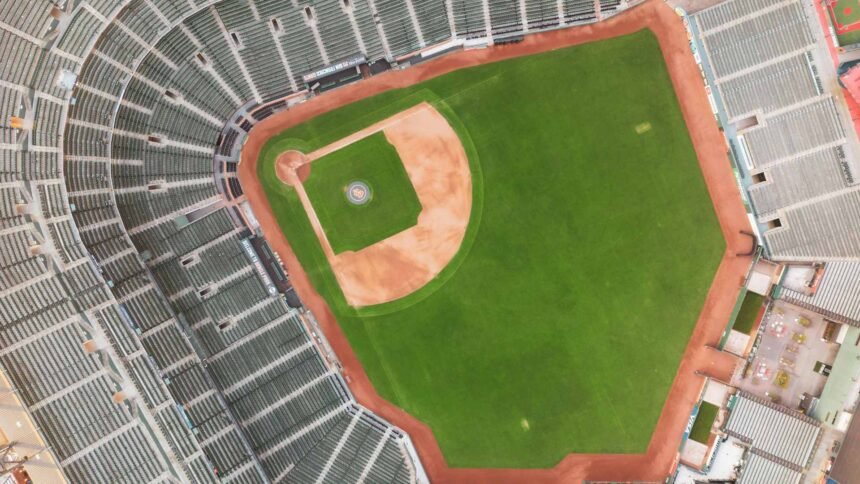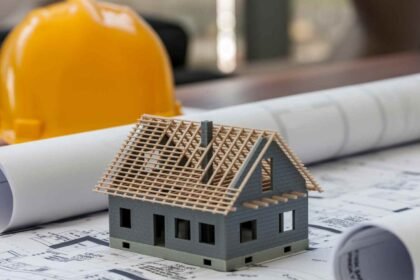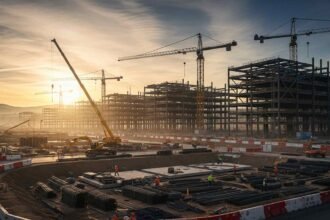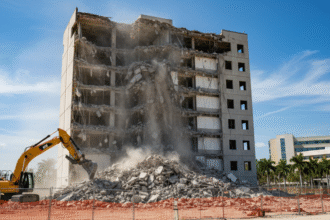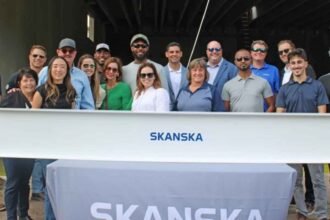The $2 billion Major League Baseball stadium
Las Vegas buzzes with excitement as the Oakland Athletics’ new ballpark project surges forward. Crews recently poured the first concrete at the site, marking a key milestone that silences doubters who feared the stadium might miss its 2028 opening. This $2 billion venture, backed by team owner John Fisher and public funds, promises to transform the Las Vegas Strip into a major league hotspot.
Background on the Project
The Athletics, long based in Oakland, decided to relocate to Las Vegas after years of struggles with their stadium back home. Nevada lawmakers approved the move in 2023, greenlighting up to $380 million in public financing for the project. The team plans a 33,000-seat ballpark on a 9-acre site where the Tropicana hotel once stood, at the southeast corner of Las Vegas Boulevard and Tropicana Avenue. Designers call it the “spherical armadillo” for its unique, rounded shape, which blends seamlessly with the city’s flashy skyline.
Initially pegged at $1.5 billion, costs climbed to $1.75 billion and now top $2 billion due to detailed designs and rising construction expenses. John Fisher and his family shoulder most of the bill, committing at least $1.1 billion initially, with the rest coming from loans and investors. The team secured a $300 million loan from U.S. Bank and Goldman Sachs, and Aramark Sports + Entertainment joined as an investor and concessionaire, possibly injecting $100 million in equity. Public money stays capped at $380 million, ensuring taxpayers don’t foot extra costs.
The A’s broke ground two months ago, in June 2025, with fanfare that drew crowds and media attention. While the team plays temporarily in Sacramento—facing heat waves and minor league vibes—they eye Las Vegas as their future home. This relocation mirrors other MLB shifts, like the Expos becoming the Nationals, but with Vegas’s tourism twist.
The Major Milestone
Construction crews hit a big win this week: they poured the first concrete at the site. This step follows the installation of nearly 600 foundation pilings, with deep foundational work now 50% complete. Hundreds of workers swarm the site daily, operating cranes that now poke above street level, visible to passersby on the Strip.
A’s president Marc Badain shared the update at a Las Vegas Stadium Authority meeting, saying the team expects vertical construction—think rising walls and decks—to start by late September or early October. Permits for steel work should clear by November, keeping everything on pace. Stadium Authority chair Steve Hill praised the progress, noting how the visible activity reassures the public after years of planning.
This milestone matters because it proves the project moves beyond talk. Grading began in late April, and now concrete flows, signaling real momentum toward the 2028 season opener.
Overcoming Challenges
Doubts loomed large about hitting the 2028 deadline. Rising costs sparked fears that funding gaps could delay work, especially as inflation bit into budgets. Skeptics pointed to the A’s interim struggles in Sacramento, where extreme weather and low attendance highlighted relocation pains. Some worried the compact 9-acre site might complicate building, or that permitting hurdles could slow things down.
Yet, the team pushes back. Badain insists funding covers the full $2 billion, with contingencies baked in. Fisher echoed this in July, confirming costs exceed $2 billion but affirming site work rolls on. The county’s permitting process earns high marks, described as “outstanding.” Plus, the project exceeds community goals: 16% of contracts go to small, local businesses, adding $7 million to the economy, and workforce rules ensure diversity and fair wages.
The Stadium Authority even appointed Jason Frierson, a former U.S. attorney and Nevada Assembly speaker, to oversee community benefits, replacing a departing chair. Once open, the team pledges at least $2 million yearly for local causes. These steps show how the A’s tackle criticism head-on, turning potential roadblocks into strengths.
Economic and Business Impact
This stadium isn’t just for baseball—it’s a business powerhouse. It will create thousands of jobs during construction and hundreds more once operational. Las Vegas, already home to the Raiders’ Allegiant Stadium, adds another venue to attract tourists and events. The ballpark’s cost now surpasses Allegiant’s $1.9 billion, setting a record for MLB venues.
Investors like Aramark signal confidence, blending food services with equity stakes. For Fisher, who considered selling team shares, this project cements his legacy. Economists predict boosts in tourism taxes, funding public services without raising rates. But critics warn of traffic snarls on the Strip and question if public dollars yield enough return. Still, supporters argue sports venues like this spark billions in spending, from hotels to restaurants.
Future Prospects
Looking ahead, the A’s aim to finalize a guaranteed maximum price soon, unlocking tax district funds. Steel arrives early next year, with the full structure rising by 2026. By 2028, fans could watch games under the desert sun or in air-conditioned comfort, given the Vegas heat.
The team, currently last in their division, hopes the new home revives fortunes. MLB expands its footprint, tapping Vegas’s entertainment market. If all goes well, this stadium could inspire other relocations, blending sports with business innovation.
The Athletics’ Las Vegas ballpark defies skeptics by hitting this concrete-pouring milestone, staying on track for 2028. John Fisher and his team deserve credit for navigating costs and challenges with determination. As cranes dot the skyline, Las Vegas inches closer to major league status. This project reminds us that big dreams, backed by smart planning, can become reality—even in the face of doubt. Watch this space; the game’s just beginning.


